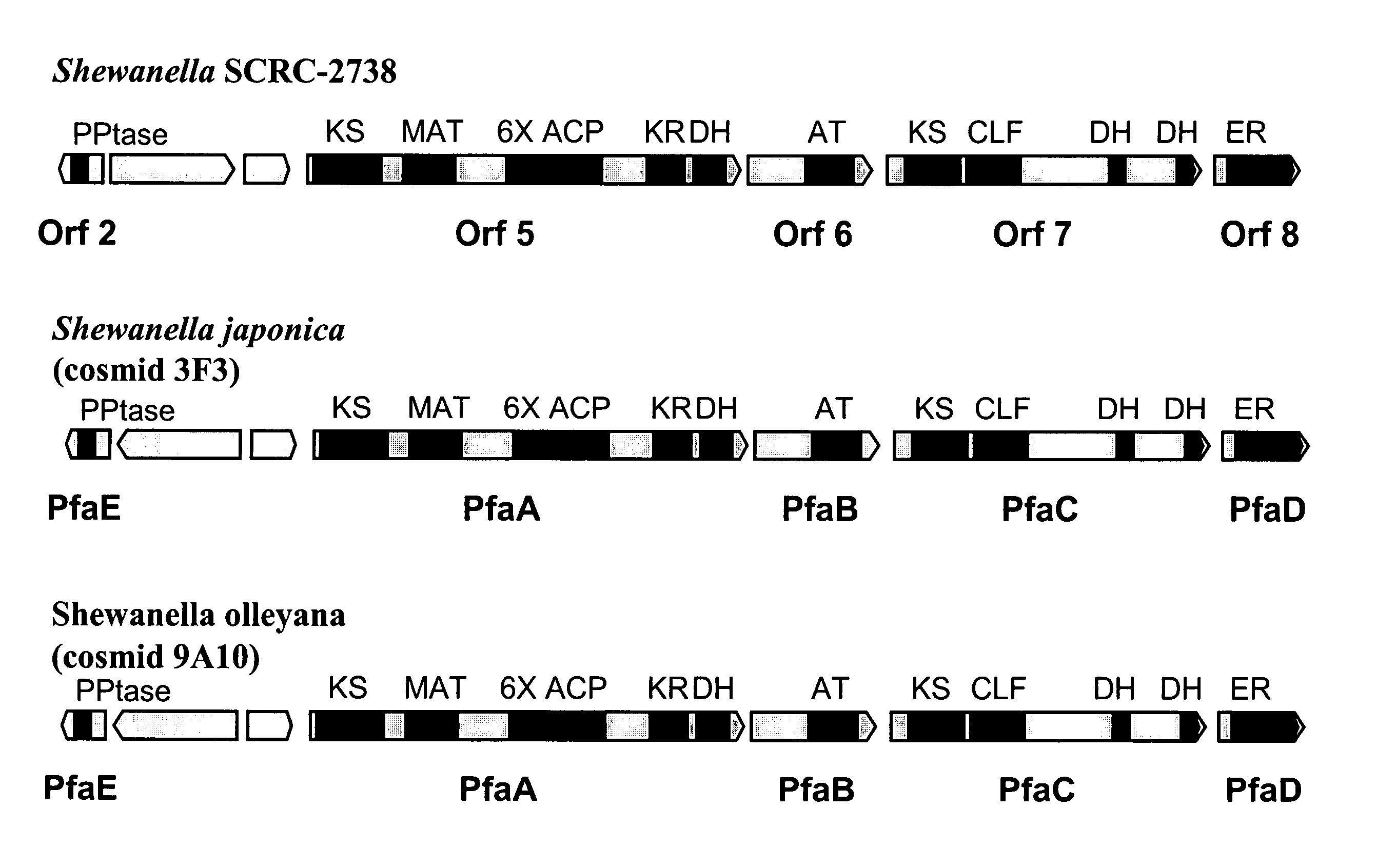PUFA polyketide synthase systems and uses thereof
a polyketide synthase and polyunsaturated fatty acid technology, applied in the direction of transferases, bacteria peptides, peptide sources, etc., can solve the problems of declining fish stocks, insufficient commercial supply of pufas from natural sources and chemical synthesis, and inability to meet the needs of commercial demand
- Summary
- Abstract
- Description
- Claims
- Application Information
AI Technical Summary
Benefits of technology
Problems solved by technology
Method used
Image
Examples
example 1
[0271]The following example shows that certain EPA-producing bacteria contain PUFA PKS-like genes that appear to be suitable for modification of Schizochytrium.
[0272]Two EPA-producing marine bacterial strains of the genus Shewanella have been shown to grow at temperatures typical of Schizochytrium fermentations and to possess PUFA PKS-like genes. Shewanella olleyana (Australian Collection of Antarctic Microorganisms (ACAM) strain number 644; Skerratt et al., Int. J. Syst. Evol. Microbiol 52, 2101 (2002)) produces EPA and grows up to 25–30° C. Shewanella japonica (American Type Culture Collection (ATCC) strain number BAA-316; Ivanova et al., Int. J. Syst. Evol. Microbiol. 51, 1027 (2001)) produces EPA and grows up to 30–35° C.
[0273]To identify and isolate the PUFA-PKS genes from these bacterial strains, degenerate PCR primer pairs for the KS-MAT region of bacterial orf5 / pfaA genes and the DH-DH region of bacterial orf7 / pfaC genes were designed based on published gene sequences for S...
example 2
[0287]The following example demonstrates the generation, identification, sequencing and analysis of DNA clones encoding the complete PUFA PKS systems from Shewanella japonica and Shewanella olleyana.
[0288]Shewanella japonica and Shewanella olleyana recombinant libraries, consisting of large genomic DNA fragments (approximately 40 kB), were generated by standard methods in the cosmid vector Supercos-1 (Stratagene). The cosmid libraries were screened by standard colony hybridization procedures. The Sh. olleyana cosmid library was screened using two separate digoxigenin-labeled probes. Each probe contained a fragment of DNA homologous to a segment of EPA biosynthetic gene clusters described in Example 1 above and respectively represent both ends of the clusters. These probes were generated by PCR using Sh. olleyana DNA as a template and primers prRZ23 (SEQ ID NO:25) and prRZ24 (SEQ ID NO:26) for one probe and prRZ28 (SEQ ID NO:27) and prRZ29 (SEQ ID NO:28) for a second probe. Example ...
example 3
[0302]The following example demonstrates that Schizochytrium Orfs A, B and C encode a functional DHA / DPA synthesis enzyme via functional expression in E. coli.
[0303]General Preparation of E. coli Transformants
[0304]The three genes encoding the Schizochytrium PUFA PKS system that produce DHA and DPA (Orfs A, B & C; SEQ ID NO:13, SEQ ID NO:15 and SEQ ID NO:17, respectively) were cloned into a single E. coli expression vector (derived from pET21c (Novagen)). The genes are transcribed as a single message (by the T7 RNA-polymerase), and a ribosome-binding site cloned in front of each of the genes initiates translation. Modification of the Orf B coding sequence was needed to obtain production of a full-length Orf B protein in E. coli (see below). An accessory gene, encoding a PPTase (see below) was cloned into a second plasmid (derived from pACYC184, New England Biolabs).
[0305]The Orf B gene is predicted to encode a protein with a mass of ˜224 kDa. Initial attempts at expression of the g...
PUM
| Property | Measurement | Unit |
|---|---|---|
| β-ketoacyl-ACP synthase | aaaaa | aaaaa |
| nucleic acid | aaaaa | aaaaa |
| polyunsaturated fatty acid | aaaaa | aaaaa |
Abstract
Description
Claims
Application Information
 Login to View More
Login to View More - R&D
- Intellectual Property
- Life Sciences
- Materials
- Tech Scout
- Unparalleled Data Quality
- Higher Quality Content
- 60% Fewer Hallucinations
Browse by: Latest US Patents, China's latest patents, Technical Efficacy Thesaurus, Application Domain, Technology Topic, Popular Technical Reports.
© 2025 PatSnap. All rights reserved.Legal|Privacy policy|Modern Slavery Act Transparency Statement|Sitemap|About US| Contact US: help@patsnap.com



